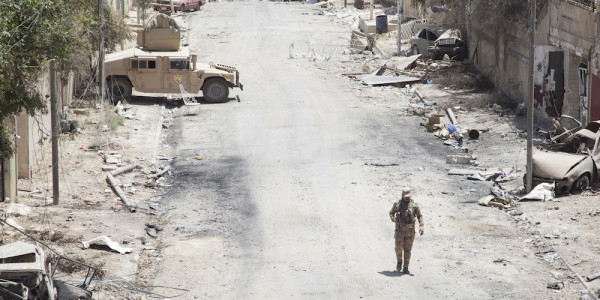

President Donald Trump may believe the U.S. military has soundly defeated ISIS in Syria, but a new report suggests that the terror group is simply biding its time in its home country of Iraq ahead of a deadly resurgence.
According to a new analysis by in Jane’s Intelligence Review, ISIS is “exploiting the chaotic and unresolved security situation” in Iraq to reconstitute itself, regaining a territorial foothold in the country’s northern Qara Chokh mountains despite the loss of its primary stronghold in Mosul just over a year ago.
“[ISIS] is exploiting remote, often sparsely populated areas in which it can establish a physical and logistical infrastructure to offer shelter and food for its fighters,” explains Dr. Jonathan Spyer in Jane’s.
These mountain footholds, like the tunnels that have stymied U.S. forces in the anti-ISIS fight in Syria, are “strongholds for the movement, where it may exercise control, from which operations can be planned and launched, where it may domicile its leadership and its most committed cadres, and to which it can fall back when facing pressure from the ISF and Kurdish Peshmerga forces,” he added.
Spyer, a longtime Middle East analyst and chronicler of ISIS’ evolution, has actively observed ISIS activity near the Qara Chokh mountains over the last several months, and and the long-term implications of these growing strongholds are clear, per his report in Janes: “Ultimately, the group may seek to develop (or revive) its capability to conduct operations across far broader area, including into Baghdad, Mosul city, and Samarra, and then onwards into Syria and Iran.”
Who’s to blame for this sudden resurgence? According to Jane’s, it’s partially the ISF who spent too much time clashing with the Kurdish militias that are ostensibly their allies in the anti-ISIS fight rather than thoroughly ridding the remote regions of the country of ISIS holdouts.
“The ISF has not attempted a comprehensive ‘cleaning out’ of the inhabited villages in this area,” Spyer writes. “This has enabled the Islamic State to establish a presence inside many of them, and to seek to disrupt and destroy communication between local tribal structures and the security forces – assisted in this by the sectarian of certain ISF elements.”

An Iraqi security forces member provides security near a patrol base in Mosul, Iraq, June 22, 2017.U.S. Army/Cpl. Rachel Diehm
The Jane’s report comes during a period of major uncertainty for both Operation Inherent Resolve and the multinational alliance to defeat ISIS itself. On Dec. 19, Trump abruptly announced the complete withdrawal of U.S. forces from Syria; days later, top Trump administration envoy to the Global Coalition to Defeat ISIS and diplomatic architect of the anti-ISIS mission Brett McGurk resigned in protest.
“We have defeated ISIS in Syria, my only reason for being there during the Trump Presidency.” Trump tweeted on Dec. 19.
After months of embracing an indefinite U.S. troop presence in Syria, a phone call with Turkish President Recep Tayyip Erdoğan reportedly inspired Trump to order the withdrawal in direct conflict with counsel from Secretary of Defense James Mattis, who resigned that day in protest.
“Ultimately, the group may seek to develop (or revive) its capability to conduct operations across far broader area”— Dr. Jonathan Spyer
According to Pentagon data released part of an August inspector general report for Operation Inherent Resolve and Operation Pacific Eagle–Philippines, ISIS has an estimated 15,500 to 17,100 fighters in Iraq, as well as 14,000 fighters in Syria. A report from a United Nations panel of experts released at the same time concluded that ISIS “has up to 30,000 members roughly equally distributed between Syria and Iraq and its global network poses a rising threat.”
For their part, OIR officials appear confident they can wipe out the remaining pockets of ISIS fighters floating around in Iraq’s northern regions.
“The ISF are relentlessly pursuing ISIS fighters wherever they hide,” an OIR official wrote on Twitter on Dec. 22 amid the Syria withdrawal chaos, accompanied with aerial footage of an airstrike on a purported ISIS hideout. “The Coalition will continue to provide support and joint fires as needed to bring about the lasting defeat of ISIS in Iraq.”
“The ISF are relentlessly pursuing ISIS fighters wherever they hide. The Coalition will continue to provide support and joint fires as needed to bring about the lasting defeat of ISIS in Iraq.” – @USArmy Col. Jonathan Byrom, JOC – I deputy commander. https://t.co/5aHuWRHfqc pic.twitter.com/xR26ZGsAGV
— Operation Inherent Resolve (@CJTFOIR) December 22, 2018
But whether the ISF and their international partners can completely root out ISIS fighters remains to be seen, according to the Jane’s report — and those forces may not even experience the full consequences of overlooked footholds until years later.
“This does not appear to herald an imminent large-scale campaign,” writes Spyer of the ISIS footholds in northern Iraq. “Rather, the Islamic State appears to be in a phase of rebuilding its structures to prepare for a future recommencement of insurgency in Iraq, accompanied by a steady drip of armed attacks.”
SEE ALSO: Turkey Prepares To Shoulder The Fight Against ISIS In Syria Ahead Of The US Withdrawal
WATCH NEXT:
